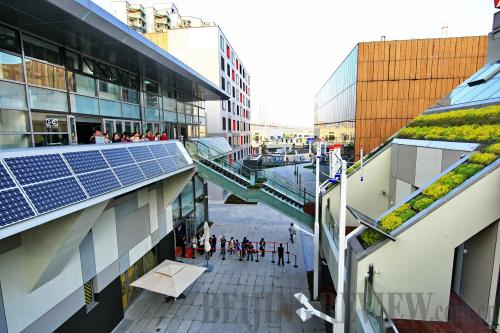|
 |
|
ENVIRONMENT FRIENDLY: The ZED (zero energy development) Pavilion at the World Expo's Urban Best Practices Area, China's first public building to have zero-carbon emissions (YU XIANGJUN) |
There's only one pavilion at the 2010 Expo with walls that illuminate, edible tableware and chairs made from used oil barrels. It's also the same pavilion where kitchen waste is used to generate power and heat.
The ZED (zero energy development) Pavilion at the World Expo's Urban Best Practices Area (UBPA) has become China's first public building to have zero-carbon emissions.
As London's contribution for the 2010 World Expo's UBPA, the complex consists of two connected carbon-neutral buildings totaling 2,500 square meters. The four-floor buildings house a lecture hall, a restaurant, an exhibition hall and six model rooms. Six designers have created different styles for the rooms, which all have environmentally friendly furniture and decoration.
The inspiration for London's UBPA came from the Beddington Zero Energy Development (BedZED), the first zero-carbon emission community in the world. Located in London, the community of 82 units of various styles was built in 2002.
The utility of sunshine, water and wind is fully embodied in the buildings of London's UBPA Pavilion. At the south side of the buildings, a sunroom saves heat absorbed from sunlight, which is transferred into the interior, while solar photovoltaic panels on the roof convert solar energy into electric energy. Through the roof, the pavilion also collects rainwater, which is used to flush toilets or to water plants, reducing the demand for tap water.
The 22 colorful wind caps installed on the roof rotate with the wind, continuously sending fresh air to each room via warm pressing and wind pressure. At the same time, solar energy and river water are used for cooling and dehumidification of the fresh air coming into the rooms.
Additionally, a special insulating layer made from recycled materials that envelops the buildings helps lower their energy consumption. The insulation will help keep the building's indoor temperatures cooler during the summer while heat will be locked in during cold months. The buildings are also airtight to reduce energy used for heating or cooling when the windows are closed.
Thanks to the fluorescent paint on the walls, the solar energy collected by the building during the day can be released as fluorescent light at night, turning the entire pavilion into a luminous building.
At the pavilion's restaurant, the lamps are made from beer bottles, chopsticks from chocolate, cookies for plates and the beer mugs are made from ice.
During Expo 2010, a series of public benefit activities are held in the pavilion focused on energy saving and emission reduction, including a Zero-carbon Garment Festival, Zero-carbon Arts Festival and Zero-carbon Culture Festival. The two-week-long Zero-carbon Exhibition, sponsored by the University of Nottingham, British Academy of Architecture and the World-Wide Fund for Nature, will exhibit from various angles the methods and achievements of human endeavor against climatic change.
Chen Shuo, chief coordinator of the pavilion, told Shanghai-based Xinmin Weekly that although the ZED Pavilion in Shanghai used British technologies, its materials and products were all made in China. "We hired Chinese manufacturing companies to build whatever we needed according to drawings and blueprints from Britain," Chen said.
He said not all designs suit Shanghai's local conditions and his team had to localize and alter some of them. He said they built a pipeline to transfer water from the Huangpu River into their pavilion to reduce the room temperature during Shanghai's sweltering summer. They also changed the shape of the wind caps on the rooftop. Instead of using wind cowls with round cross-sections like those in BedZED, the pavilion used cowls with triangular cross-sections, which can be better powered by the milder winds in Shanghai.
"These are two different projects. We have developed technologies that suit China's conditions. China's climate and industrial development levels have made the country more competitive than Britain for building low-carbon architecture," Chen told Economic Daily. He estimated that China's first experimental zero-carbon emission community could appear as early as two years from now. He said the major problem is how to make zero-carbon buildings more affordable.
Chen said, unlike most pavilions that will be demolished after the Expo is over, the ZED Pavilion will live on to become China's first zero-carbon museum. | 